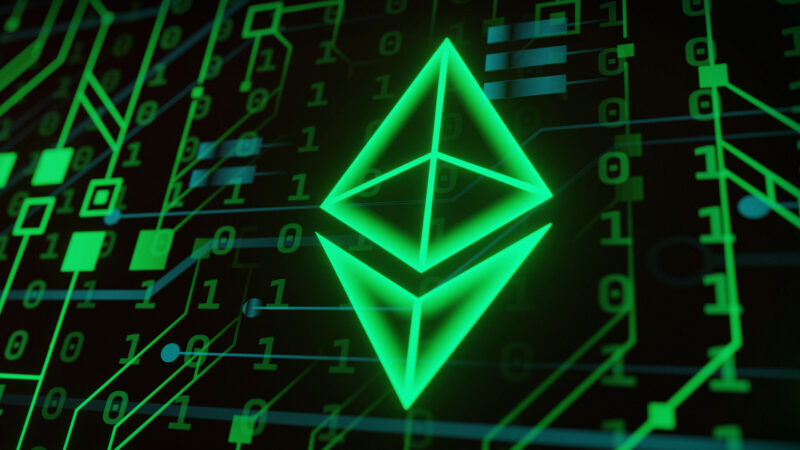Ethereum is probably going to rocket over the next few years. To understand why we got to look at this guy Squish Chaos’s thesis. It includes 4 of the strongest reasons I’ve ever seen, and it culminates with the price prediction that is going to blow your mind.
Reason number one is that the amount of ETH in circulation is about to decrease significantly. Why does that even matter? Because if there’s less circulating supply then there’s less potential ETH that could be dumped on the market. Basic economics, if demand stays the same and we reduce supply then the price has to go up. That’s why it’s super bullish to see ETH getting removed from circulation.
One way that happens is when ETH gets locked in DeFi protocols. just look at the chart representing the number of ETH that’s being locked across DeFi. The chart has been dropping since late last year. But I attribute that to normal bear market forces, and I fully expect it to go back up as we enter the next bull market.
There’s also this chart that represents the amount of Ether locked in the beacon chain. This is a much stronger force than DeFi staking because here you cannot withdraw your eth until a few months after the big upgrade. So it’s super impressive to see this chart going up and to the right.
Almost 13 million ETH is being staked there currently and I fully expect that number to grow as we get closer to the upgrade. Because there will be less uncertainty about how long the capital will be locked up for. But I think the strongest force of them all is the burning mechanism that was introduced last year. Because that permanently remove ETH from circulation. So far that’s amounted to almost 2.5 million ETH burned, which is roughly 58% of all ETH issued during that same time. that is a massive amount and because it comes out of every transaction fee that means it’s only the liquid, circulating ETH that gets burned. Not the ETH that’s being staked.
Why is this huge? Every time ETH is locked in DeFi, locked in the beacon chain, or burned as a result of sending a transaction. That means less ETH is available in the circulating supply. And basic supply and demand dictates that the price must go up.
But of course, that’s only if we assume that demand stays the same. Actually, there’s good reason to believe that demand will go up instead. This projected increase in demand is actually reason number two of why ETH will dominate, and a big part of this demand is going to come from institutions. It’s honestly way easier for them to get into crypto these days. Before they had to use the same ragtag products as we did, but you can imagine how their legal and compliance teams would feel about that.
But nowadays the landscape is so different and there’s products and services tailored made for institutions. Now better access is of course important but an even bigger reason why institutions will want Ether is the staking yield that comes with it.
There’s just not a lot of ways to earn high quality yield on your capital these days. Institutions have to resort to junk bonds or other shady financial instruments to get any sort of meaningful yield. But that’s because they haven’t come across Ether yet. With Ether they can stake to earn great yields and they don’t have to worry about the network disappearing the next day. In fact, more and more institutions may start to view staked Ether as an equity investment in the underlying network. If you consider stocks, those have price to earnings ratios, buybacks, and dividends. But for Ether, the yield is the dividend, the burn is the buyback, and the earnings are the fees generated by the network. So you can even calculate price to earnings ratios for Ether and analyze it using a traditional stock framework.
But I think the most enticing thing about this yield is that it is independent of price. Let’s say you’re an institution, you have 1,000 ETH. Yield is at 4% so after one year you get 40 ETH from staking, but you get that 40 ETH regardless of the price. So if ETH is $1,000 that’d be $40,000 worth of passive income. But if ETH is $10,000. Your yield would be worth $400,000 instead.
You see why institutions are going to gobble this up?
Now, all this talk about institutions is cool but don’t forget about us retail investors because more demand is going to come from us too. The first driver here is better user experience. Gone are the days of clunky wallets and expensive gas fees. With wallets like argent that are natively integrated with layer 2 networks the onboarding experience for new users will be 100x better than before. Also, we can expect a bunch of new use cases to emerge due to these layer 2 networks. These L2s will enable fast speeds and low fees all while maintaining the same decentralization and security of Ethereum.
So all these new use cases that weren’t feasible before will be invented. And those could bring a lot of new retail demand. Just dreaming out loud here, maybe some awesome blockchain games, or some brand-new utility for NFTs. The sky is the limit here. Anyways the point is that we’re going to see a lot more demand for ETH over the next few years. Courtesy of both institutions and retail.
But then the question becomes when this all is going to play out? Well that brings us to reason number three to be bullish. Which is all the catalysts coming up that are going to kickstart these supply and demand drivers. The first catalyst already happened, that’s the upgrade last year called EIP-1559. This introduced the burn mechanism that plays a huge role in reducing the circulating supply, but the biggest catalyst of them all is the merge to proof of stake. This is the next massive upgrade that we’ve all been waiting for because it will reduce ETH issuance by whopping 90 percent. And depending on demand that can make ETH net deflationary. Which is something even bitcoin cannot boast. But the main problem here is that the merge has been delayed several times, and people are starting to wonder if it’ll ever come.
To that I’ll say don’t worry because you can see the progress being made if you follow the Devs closely enough. And also, I just think it’s better to do this in a slow but safe manner so that the billions of dollars sitting in Ethereum DeFi won’t be harmed along the way.
So those two catalysts are for the supply side. But there’s also a strong catalyst on the demand side too. That would be the air drops that all these up-and-coming layer 2 networks are giving out. Those are really going to kick off a layer 2 season where retail investors flock to those networks in hopes of qualifying for their airdrops. The theory here is that retail is going to see how great of an experience these L2s can offer. So they decide to stay and keep their capital in the broader Ethereum world. This would definitely increase demand for ETH because all these layer 2 networks ultimately settle on Ethereum, so they need to buy ETH in order to operate.
Now in just a minute I’m going to share the ultimate price prediction that comes with this thesis. But we’re still missing one final reason which ties it all together and brings us to that prediction. This reason number four would be the powerful narratives emerging around ETH.
If you’ve been in the crypto world for more than one cycle, you’ll know how powerful narratives can be. Like of course fundamentals are important but narratives are like rocket fuel, and they can kickstart adoption and move the price too. So in terms of Ethereum, one upcoming narrative is that ETH can scale. This is made possible by the arrival of layer 2 networks which are built on top of Ethereum. These are fast, cheap, and they’re arguably better than other layer 1 networks because you can bridge from layer 2 to layer 2 without sacrificing security. That’s why there’s this growing narrative that modular blockchain architectures are better than monolithic ones.
This gets a little bit complicated, but the idea is that all blockchains need to fulfill three separate functions: Execution, Settlement, and Data Availability. One approach is to do it all on a single blockchain which is what Solana does, but the argument is that it’s better to split up these functions into specialized blockchains, and then connect them all together. Like execute the transactions on optimism, settle them on Ethereum, and then handle data availability on Celestia.
Personally, I do think that modular is better than monolithic. It’s not because I’m an ETH Maxi or anything, I just think the argument is convincing. But the whole point here is that people are starting to use these L2 networks more and more. Which will bring them back to ethereum and also feed into the narrative that ETH can actually scale.
Another important narrative to look out for is the one that ETH Devs can actually deliver on their promises. People love to hate on ETH Devs for taking their sweet time instead of locking themselves up in the room and churning out ETH 2 in a few months and then ETH 3 after that. But I do think that their approach makes sense, and also, they’ve been making great progress – the EIP-1559 upgrade was launched last year, layer 2 networks are already coming online, and every day brings us one step closer to the merge.
Once that big upgrade finally happens. People are going to notice all this forward momentum by the Devs. And they’re going to realize that the Devs just might be able to deliver on that ambitious roadmap that Vitalik laid out. And that would be a sight to behold. It would make Ethereum the only blockchain to truly be scalable, decentralized, and secure all at the same time without any trade-offs.
But let’s take a step back and ask what this all means? Well, it means that ETH is going to completely rocket and dominate over the next few years. These four reasons, the supply, the demand, the catalysts, and the narratives all come together to support a base price of thirty to fifty thousand dollars per Ether. That’s a 30 to 50x from current prices and he’s expecting them in the next few years. These numbers weren’t just pulled out of thin air by the way. The author of this thesis used several numerical models and frameworks to come up with his range. He can defend it better than I can, so I’ll just drop the link to his original report below. In that report he also predicts that we could see $150,000 ETH for a brief blow off top.
Now I’m sure you’re super skeptical about that because that market cap would be some ungodly 18 trillion dollars at that point. But if the supply is ultra-liquid and we’re in a stage of euphoria then maybe I could see it.
Triple Halving Report by Squish Chaos: https://squish.substack.com/p/the-triple-halving-where-we-stand




